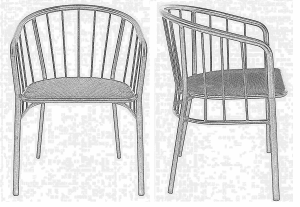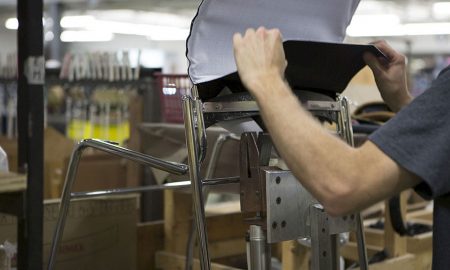The Place of Metal in Furniture Design
Since the ancient times, metal materials have been used in many areas as well as in furniture production. Metals, which were mostly used as joining elements, accessories and carriers, are now also used to form a complete furniture. Bronze, gold, silver and iron are the most widely used metals in the past, while steel and aluminum are the most used metals in today’s furniture production.
The processing of the metals does not differ much from the previous periods. They can be formed by bending with heat, by force effect or by cutting, drilling and abrasion techniques. However, the advancement of technology and the continuous development of new production techniques and new materials also contribute to the creation of new forms. The metals used in furniture production are the preferred materials for industry, designer and consumer thanks to its technological opportunities and psychological effects. The ease of forming and joining of the material, its ability to be found in standard sizes, its durability and its ability to recycle is assuring.
Metals psychologically often symbolize magnificence or advanced technology. However, since the perception and technological characteristics of each metal may be different, it is important to make the selection based on where and for what purpose the material will be used. For example, stainless steel in places requiring hygiene, aluminum in places where lightness is important, or bronze or gold may be preferred in places where it is desired to emphasize glory.
In today’s conditions, where technology is constantly developed, borders are removed, everything is rapidly changing, also affects furniture design. Mass production is inevitable in the presence of the need for fast, trouble-free and economical production. Furniture design is now driven by technological innovations. While the material technology is constantly being developed, the psychological aspect of furniture also gains importance in order to stand out in competitive conditions.
Metal materials have found its place in various areas in the industry with features such as high heat and electrical conductivity, brightness and tendency of changing shape. The production of various metals in modern industry has provided the use of these materials as an alternative to wood in building and furniture sectors.
The first thing that comes into mind when mentioning of furniture are products made from wood. Undoubtedly, this prejudgement is a result of wood being the most used material in furniture production from past to present. Unlike metal furniture, technology, production and design publications and research on wood furniture can widely be found. However, iron and aluminum are readily available elements in earth and also recyclable.
Increasingly, both metals and usage areas become varied. The use of metals in the furniture industry is expanding and contributing to the furniture design. The importance of the use of metals in furniture design result from its suitability for industrial production, as they are fast, mass and economical. Metal, unlike wood, does not vary in features, it is important to have mass production with care.
With the help of machines, heavy materials can easily be processed and the parts can easily be replaced with small joining elements when necessary. This feature of the material provides advantages in transportation, storage and shipping of the products. The metal being flexible and yet durable has brought new possibilities to furniture design. Metals are materials that can easily form into desired shapes.
Design possibilities are expanding with new production technologies. However, the metals other than aluminum used in furniture being heavy, limits the use of these materials in furniture. Due to the fact that aluminum is a light metal, its technologies have developed and the use of aluminum has become widespread. The non-porous, easily cleanable and odor-free structure of metals has made this material indispensable in hospitals and kitchens that require hygiene.
In furniture, metal was used in the form of decorative accessories or reinforcing elements before the 19th century. From the 19th century onwards, furniture completely made of metal has been widespread. Although metal has achieved superiority against wood with its industrial production predisposition, the wood technology has been quite developed since the 20th century. Moreover, new materials based on plastic have been found and gained place in the furniture industry. However, the metal material has become a symbol of this period with the modern movement at the beginning of the 20th century and still continues to be an expression of modernism, advanced technology, as well as power and wealth. Despite some negative aspects such as its weight, size limitations, metal materials are preferred due to being recyclable, durable and low maintenance costs.
Today, the developments in especially steel and aluminum technology emerge with innovations. The innovations that continuously developing metal materials can bring to furniture design, technology-design-user relations are important.
Furniture are the reflections of social, economic and cultural level. The choice of materials, their usage, designing style, colors give hints about the period they are in. Besides, a new material or a new style is often presented firstly as a chair. For example, metal chairs and their variations can easily be tested and introduced to the sector and people can directly touch and experiment it. Furniture, generally chairs, usually play an important role in the development of new materials. Metal materials have influenced furniture design from past to present thanks to the technological opportunities.








Leave a Reply
You must be logged in to post a comment.